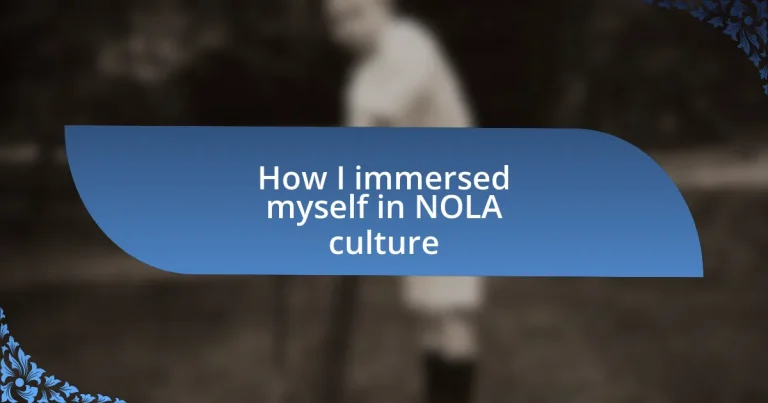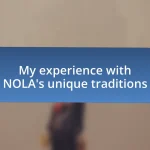Key takeaways:
- NOLA’s culture is a rich blend of African, Spanish, and French influences, expressed through music, food, and community resilience.
- Annual festivals like Mardi Gras and the Essence Festival showcase the city’s vibrant spirit, fostering a deep sense of belonging and celebration.
- Exploring local cuisine reveals storytelling through food, with dishes like gumbo and jambalaya reflecting NOLA’s diverse heritage.
- Engaging with the community through potlucks, volunteering, and literature expands understanding of local culture and shared history.

Understanding NOLA’s Unique Culture
NOLA’s culture is a vibrant tapestry woven from its rich history and diverse influences. I remember walking through the French Quarter, where the air was thick with the sound of jazz spilling from every corner, and I couldn’t help but think, “How does music become so deeply ingrained in a place?” This blended soundscape reflects not just the city’s African, Spanish, and French roots, but also the stories of its people—each note, a glimpse into their lives.
Attending a second-line parade was an unforgettable experience for me. The rhythm of the brass bands and the jubilant dancing made me feel alive as if I were part of something much bigger than myself. I often wonder how they manage to infuse such joy into their celebrations amid adversity. This resilience shines through in the city’s festivals, showcasing the strength and spirit of a community that refuses to be defined by its challenges.
As I explored local cuisine, I realized that food is a profound expression of NOLA’s identity. Each bite of gumbo or beignet took me deeper into a narrative rich with heritage. It made me ponder, “Can food truly tell a story?” In NOLA, it certainly can—each dish becomes a delicious chapter reflecting the city’s blending of cultures and traditions.
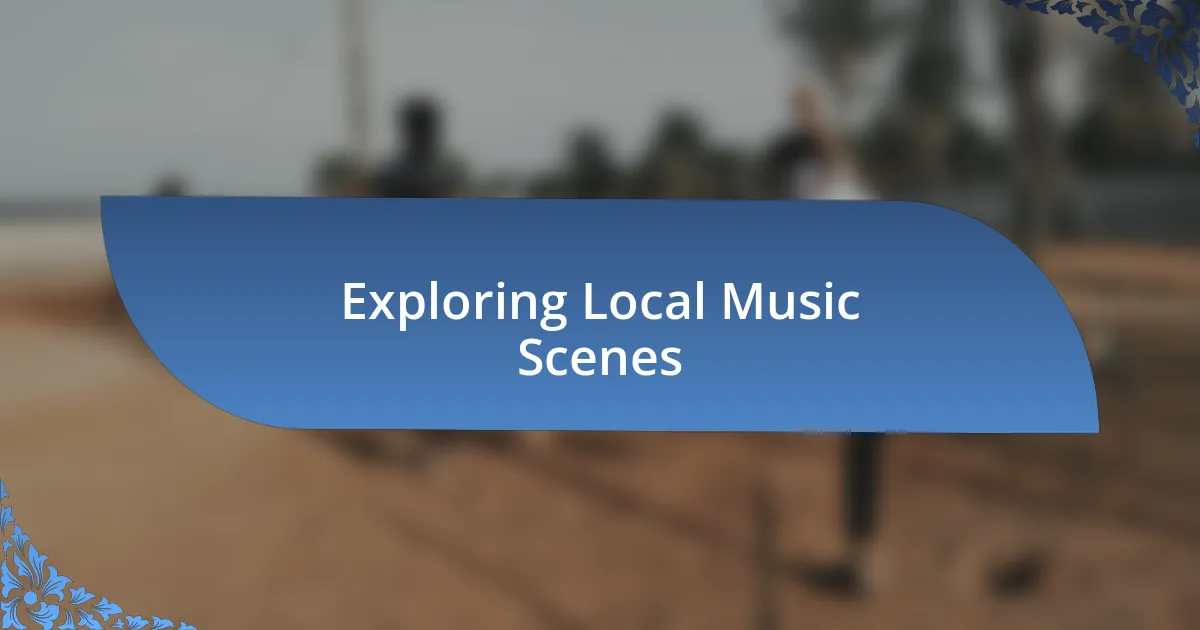
Exploring Local Music Scenes
The music scene in New Orleans is unlike anywhere else I’ve experienced. As I wandered into a small club on Frenchmen Street, the band was playing a lively combination of jazz and funk. I could feel the energy in the room—everyone was moving with the beat. This wasn’t just a performance; it felt like a communal celebration. Questions danced in my mind—how does music create such connections among strangers?
There was one night, particularly memorable, when I stumbled upon a spontaneous jam session in a local bar. Musicians of all ages shared their talents, blending traditional jazz with modern influences. I was captivated by the spontaneity and talent on display. It made me reflect on how music acts as a bridge across generations, turning a simple night out into a powerful experience that speaks to the heart of NOLA’s culture.
The variety of live music options available in NOLA is astounding. From street performers to top-tier artists, the scene invites everyone to participate. One evening, I sipped on a Sazerac while watching a street parade, and it struck me—the music here isn’t confined to stages; it spills onto every street, filling the air with life and passion. How could anyone visit NOLA and not feel the pull of its sounds? The allure of this city truly lies in its rhythm.
| Type of Venue | Music Genre |
|---|---|
| Frenchmen Street Clubs | Jazz & Funk |
| Local Bars | Spontaneous Jam Sessions |
| Street Performances | Varied Genres |
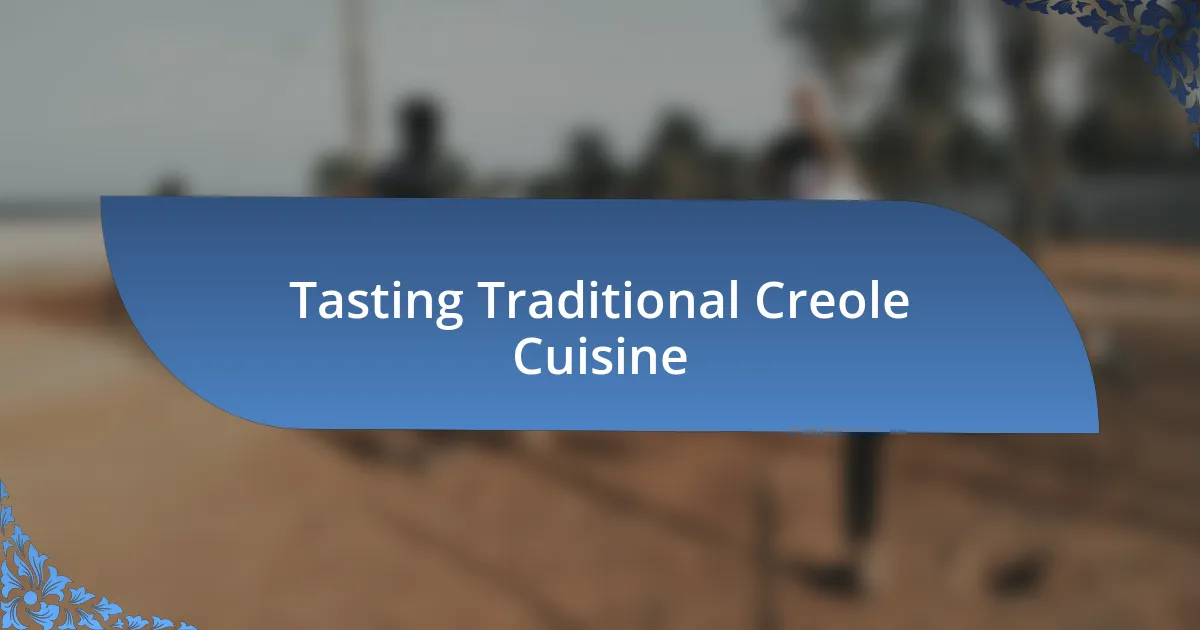
Tasting Traditional Creole Cuisine
Tasting traditional Creole cuisine in New Orleans was an intimate journey that awakened my senses. Each dish told a story, blending influences from French, Spanish, and African cultures. I vividly remember my first bite of gumbo—rich, smoky, and incredibly flavorful. The warmth of the spices seemed to wrap around me like a comforting embrace, making the bustling restaurant feel like home.
I had the pleasure of indulging in a few standout dishes during my culinary exploration, each one leaving a lasting impression:
- Gumbo: A hearty stew featuring meat, seafood, and a rich roux, brimming with flavors.
- Jambalaya: A vibrant rice dish, packed with chicken, shrimp, and spices, showcasing NOLA’s culinary diversity.
- Beignets: Irresistibly fluffy pastries dusted with powdered sugar; they melt in your mouth and evoke a feeling of pure bliss.
- Red Beans and Rice: A comforting staple reminding me of home-cooked meals, flavored with smoked sausage and served on a lazy Monday.
- King Cake: This festive treat, with its rich cinnamon flavor, became a delightful part of my Carnival season experience, symbolizing the vibrant culture of New Orleans.
Every meal was not just food; it was a connection to the heart and soul of a city steeped in tradition.
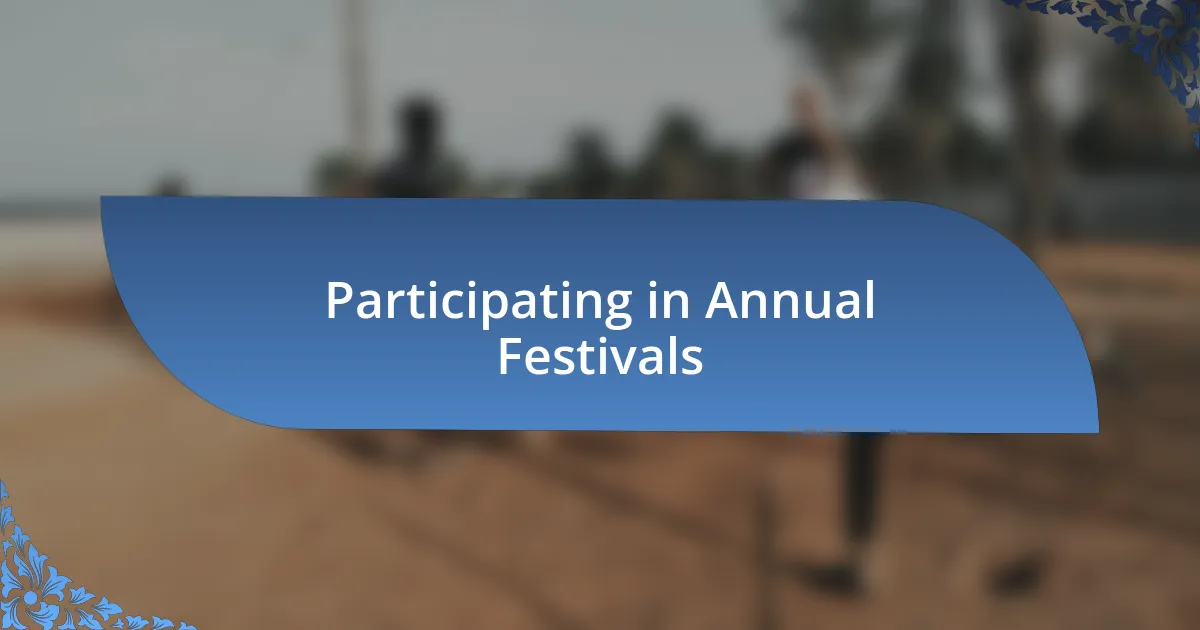
Participating in Annual Festivals
Experiencing the annual festivals in New Orleans was like stepping into a vibrant tapestry of culture and celebration. Attending Mardi Gras for the first time filled me with a sense of excitement that was contagious. The floats, adorned with vivid colors and creative designs, moved through the streets like a parade of dreams. I found myself caught up in the energy, tossing beads and experiencing the joy radiating from everyone around me—how often do you get to embrace such unrestrained exuberance?
Another highlight was the French Quarter Festival, where I wandered through the historic streets, sampling dishes from local vendors while listening to incredible live music. There was a point when I stumbled upon a brass band playing a soulful tune, and I couldn’t resist joining the impromptu dance circle that formed. The music seemed to flow through me, igniting a connection to the city’s heart. Has there ever been a moment where the rhythm of a place enveloped you like that?
As I participated in the Essence Festival, celebrating the rich heritage of the Black community, I felt a profound sense of belonging. The workshops and panels opened my eyes to the stories and contributions that shape the culture of New Orleans, making me realize how essential it is to not just celebrate but also to listen, learn, and honor these experiences. In sharing these moments, I discovered that each festival is not only a celebration but also a reflection of the city’s spirit and resilience.
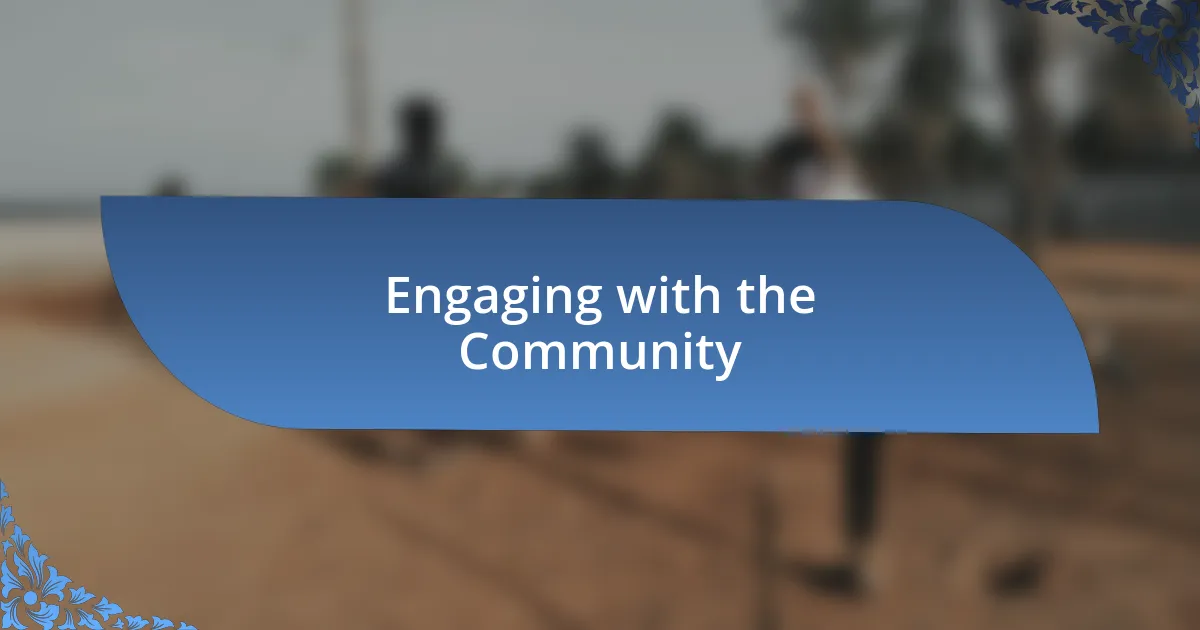
Engaging with the Community
Being in a community-focused environment in New Orleans is exhilarating. Attending a neighborhood potluck, I remember the welcoming warmth as everyone introduced themselves and shared their favorite dishes. One woman served her grandmother’s gumbo, and as I took a bite, I felt a wave of connection wash over me, realizing that food is a powerful bridge between cultures. How often do we find ourselves savoring not just a meal, but a shared history?
Volunteering at a local arts center gave me a unique perspective on the community’s heartbeat. The children I worked with were bursting with creativity, eager to express themselves through art. I found it deeply rewarding to help them paint murals that showcased their dreams and challenges. This experience made me reflect: what can be learned when we engage directly with the hopes of the next generation?
Moreover, participating in local book clubs expanded my understanding of New Orleans literature and history. Each meeting was filled with passionate discussions about not just the books but also the authors’ ties to the city. I recall a lively debate over a novel by a local writer that sparked conversations about race, community, and resilience. It made me wonder, how can literature help us navigate the complexities of our experiences? Each interaction served as a reminder that engaging with the community isn’t just about being present; it’s about connecting deeply and understanding the narratives that shape our lives.
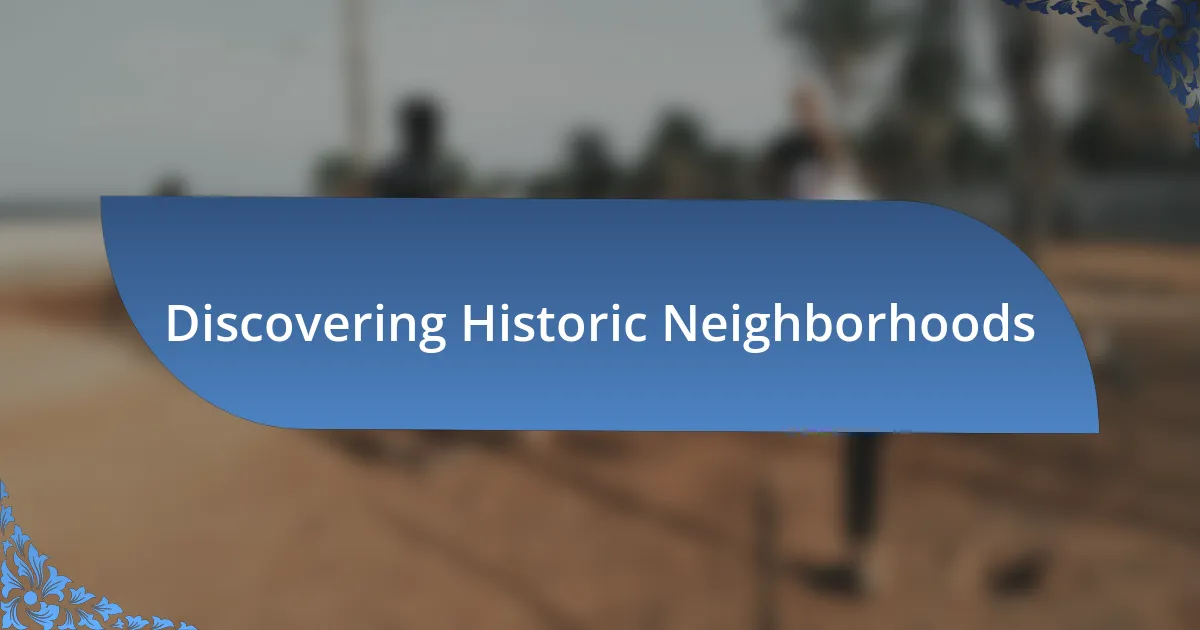
Discovering Historic Neighborhoods
Exploring the historic neighborhoods of New Orleans felt like stepping into a living museum. Each area, like the colorful French Quarter, exuded distinct character through its architecture and stories written in the bricks. I remember wandering down Chartres Street, captivated by the jazz drifting from open windows. It sparked a question in my mind: how does the city’s music reflect its resilience and spirit?
As I ventured into Treme, the nation’s oldest African American neighborhood, I felt a profound energy pulsating through the community. The haunting beauty of the old homes contrasted with the vibrancy of local street art. One day, I chatted with a resident who shared tales of their family’s history dating back generations, imbuing the place with an almost sacred reverence. It made me ponder: what role does history play in our identity, and how do these stories shape the future?
Every corner I turned revealed yet another layer of culture and history, especially in the Garden District with its opulent mansions and lush gardens. I recall sitting on the steps of an old home, sipping coffee, while striking up a conversation with a couple who called the area home for decades. They reminisced about the changes they’ve witnessed, prompting me to reflect: how important is it to preserve the soul of a neighborhood amid modernization? In these exchanges, I found that each neighborhood is not just a place on a map; it’s a canvas filled with shared experiences and dreams that deserve to be celebrated.
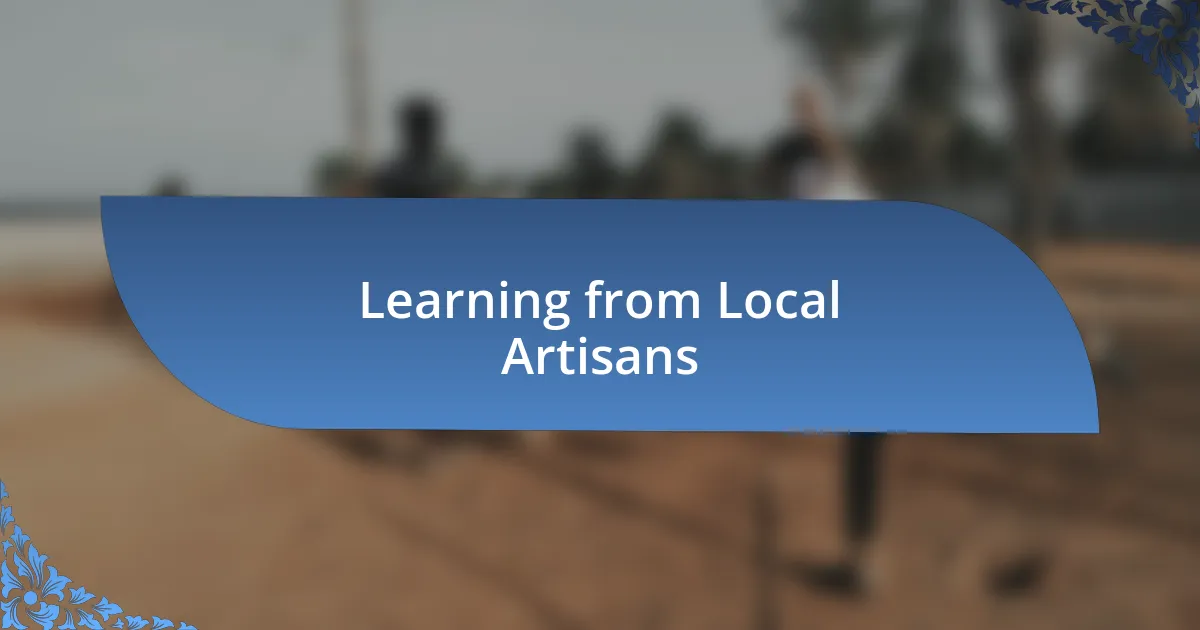
Learning from Local Artisans
Learning from local artisans in New Orleans was truly an enlightening experience. I vividly recall visiting a small workshop where a master potter shared her craft. As she shaped the clay, I felt a connection not just to her art, but to her passion. It made me wonder, how often do we appreciate the hands that create beauty around us?
One afternoon, I attended a jewelry-making class led by a local craftsman. Amid the rhythmic clinking of tools, I was surprised by the stories embedded in each piece he created. Each necklace, ring, or bracelet held a narrative of the culture and community, making me think: how does our art reflect our values and heritage?
During my time in the city, I stumbled upon a street fair where artisans showcased their skills—everything from intricate woodworking to vibrant paintings. I was struck by seeing a heartwarming collaboration as artists exchanged techniques and ideas, thriving on the spirit of shared creativity. In that moment, I realized how much the sense of community fuels not just the artisans, but the very essence of NOLA itself. What could we learn from such connections in our own lives?
